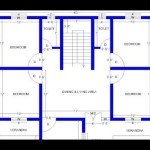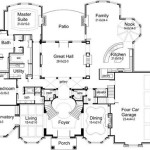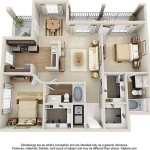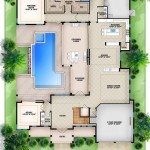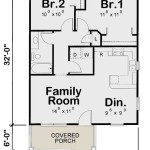First Floor Plan House Simple
A simple first-floor house plan prioritizes functionality and efficiency. It aims to maximize usable space while minimizing construction costs and complexity. This type of plan often features an open-concept layout, connecting the main living areas for a sense of spaciousness. Simple plans are ideal for smaller lots, starter homes, or individuals seeking low-maintenance living.
Key Features of a Simple First-Floor House Plan
Several key features characterize a well-designed, simple first-floor house plan: * Open Concept Living: Combining the living room, dining area, and kitchen creates a larger, more flexible space. * Minimal Hallways: Reducing hallway space maximizes square footage dedicated to living areas. * Efficient Traffic Flow: Careful planning ensures easy movement between rooms and minimizes wasted space. * Straightforward Design: Simple rooflines and rectangular footprints contribute to cost-effective construction. * Ample Natural Light: Well-placed windows maximize natural light and reduce the need for artificial lighting.
Benefits of a Single-Story Home
Single-story homes, inherently utilizing a first-floor plan, offer numerous advantages: * Accessibility: No stairs make single-story homes suitable for individuals with mobility issues and families with young children. * Easier Maintenance: Cleaning and upkeep are generally easier without the need to navigate stairs. * Energy Efficiency: Single-story homes can be more energy-efficient due to reduced air leakage and easier temperature regulation. * Safety: The absence of stairs reduces the risk of falls. * Faster Construction: Single-story homes typically have shorter construction timelines than multi-story homes.
Considerations for Designing a Simple First-Floor Plan
Careful consideration of several factors contributes to a successful simple first-floor house plan: * Lot Size and Orientation: The plan should maximize the lot's potential while considering sun exposure and prevailing winds. * Lifestyle Needs: The layout should accommodate the specific needs of the occupants, such as hobbies, work-from-home spaces, and entertaining. * Budget: A simple plan helps control construction costs by minimizing complex design elements. * Local Building Codes: Adherence to local building codes and regulations is essential. * Future Expansion: While focusing on current needs, the plan should consider potential future expansion possibilities.
Elements of a Functional First-Floor Layout
A functional first-floor layout optimizes space utilization and flow: * Clear Zone Definitions: Distinct areas for living, dining, sleeping, and service functions improve organization and flow. * Privacy Considerations: Careful placement of bedrooms and bathrooms ensures privacy within the home. * Storage Solutions: Integrated storage solutions maximize space efficiency and minimize clutter. * Outdoor Connections: Patios, decks, and porches extend living space and connect the indoors with the outdoors. * Accessibility Features: Wide doorways and hallways accommodate future accessibility needs.
Maximizing Space in a Simple First-Floor Plan
Several strategies can maximize space in a simple first-floor plan: * Multi-Functional Spaces: Rooms that serve multiple purposes, such as a guest room/office, optimize space utilization. * Built-in Storage: Maximizing vertical space with built-in shelves and cabinets increases storage capacity. * Open Shelving: Open shelving in kitchens and living areas creates a sense of spaciousness while offering storage. * Light Color Palettes: Light wall colors and flooring reflect light, making rooms appear larger. * Minimalist Decor: A minimalist approach to furnishings and decor avoids overcrowding and enhances the sense of space.
Choosing the Right Materials for a Simple First-Floor Home
Material selection impacts both aesthetics and practicality: * Durable Flooring: Consider low-maintenance and durable flooring options like hardwood, laminate, or tile. * Energy-Efficient Windows: Energy-efficient windows and insulation help reduce energy costs. * Low-Maintenance Exterior: Opt for low-maintenance exterior materials such as vinyl siding or brick. * Sustainable Materials: Consider incorporating eco-friendly and sustainable materials whenever possible. * Cost-Effective Options: Balancing quality with affordability is crucial when selecting materials.
Working with an Architect for Your First-Floor Plan
Collaborating with an architect can be invaluable in creating a successful first-floor plan: * Expertise and Guidance: Architects provide expertise in design, building codes, and material selection. * Customized Design: They can create a plan tailored to specific needs and preferences. * Construction Drawings: Architects produce detailed construction drawings necessary for obtaining permits and building the home. * Project Management: They can assist with project management and contractor selection. * Budget Control: Architects can help manage the budget and ensure cost-effectiveness.
Examples of Simple First-Floor House Plans
Various examples of simple first-floor house plans are readily available: * Ranch Style: Classic ranch-style homes offer a simple, rectangular layout. * Bungalow Style: Bungalows often feature open floor plans and covered porches. * Cottage Style: Cottages are typically small and charming, with efficient use of space. * Modern Farmhouse: Modern farmhouses combine rustic elements with contemporary design. * Minimalist Style: Minimalist homes prioritize simplicity and functionality in their design.

27 42 1st Floor Simple House Plans Square Budget

12 X45feet First Floor Plan Simple House Plans 2bhk 20x40

Simple House Plan Design With Garage

Small House Plans Beautiful Houses Pictures Floor Plan One Story

Structure 1 First Floor Plan Scientific Diagram

Simple House Plan Design With Garage

Simple Best House Plans And Floor Affordable

Simple House 1st Floor Plan Template

Small House Design 2024001 Pinoy Eplans Floor Plans Home

House Ground Floor And First Plan Drawing Dwg File Cadbull
Related Posts

